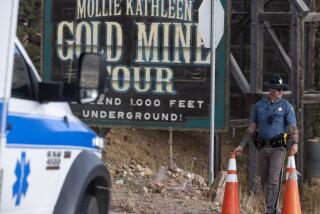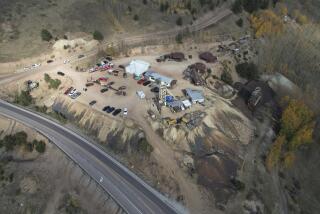Accidents on Mt. Rainier, Mt. Hood Kill 6 Climbers
TIMBERLINE LODGE, Ore. — Three climbers plunged to their deaths Thursday in a yawning glacial crevasse atop Mt. Hood, setting up a dramatic rescue effort in which an Air Force Reserve helicopter slammed into the icy summit and rolled 1,000 feet down the mountain.
All six helicopter crew members survived the crash, and six other climbers trapped in the crevasse were safely lifted off the mountain by the end of the day, though some were seriously injured.
On Seattle’s Mt. Rainier, meanwhile, rescuers recovered the bodies of three climbers who died early Wednesday--a devastating debut to a climbing season that typically draws tens of thousands of climbers to the two Cascade peaks that loom above the Pacific Northwest’s two biggest metropolises.
Dramatic images of the rescue on the 11,235-foot Mt. Hood--Oregon’s highest peak and one of the most frequently climbed mountains in the world--were playing live on television when, shortly before 2 p.m., a 20,000-pound Pave Hawk helicopter poised to pick up the injured seemed to lose lift in the thin mountain air. It struck the side of the mountain, then rolled to rest upside down on an icy berm.
Three of the six crew members were hurt. The news was worse for nine climbers who earlier in the day lost their footing and plunged down a 65-degree slope into a crevasse: Three were dead inside the 10- to 40-foot-deep chasm. Six others, including Thomas Hillman, 45, a pastor at United Methodist Church in Windsor, Calif., were admitted to Portland hospitals, four of them with serious injuries. Hillman was listed in serious condition with a head injury and possible hypothermia. His friend and climbing partner John Biggs, a former United Airlines pilot also from Sonoma County, was not listed among the injured.
As dark fell, only two of the three bodies on Mt. Hood had been recovered.
The accident occurred on a relatively balmy morning, as a team of six firefighters and their companions from the Tualatin Valley Fire and Rescue Department moved toward the summit.
Assistant Fire Marshal Cleve Joiner, who had brought his 14-year-old son, Cole, along on the climb, said his group was about 800 feet short of the summit, climbing below two teams of six other people.
Suddenly, the team at the top lost their footing, plowing down into the groups below them, taking a total of nine climbers into the crevasse, Joiner said.
“It just happened within a matter of 20 or 30 seconds,” he said.
Joiner’s son was one of the nine trapped in the crevasse. Joiner used his cell phone to call 911, summoning rescuers, though he was still unsure of the fate of his son.
“I went through all kinds of emotions,” he said. “A lot of people in my family said, ‘This is kind of a dangerous thing, are you sure you want to do this?’ I was worried about having to answer that kind of call. And then when I found out he was alive, I just fought back the tears and carried on.... At that point, you just have to kind of turn it off and then say, ‘OK, we’re in rescue mode.’”
The Air Force Reserve’s 935th Rescue Wing and the Oregon Army Air National Guard immediately dispatched helicopters to the scene. Rescue crews landed and dug out positions on the icy, 35-degree slope and set up pulleys to haul the most seriously injured out of the crevasse, aided by firefighters and Joiner’s son below.
They had pulled out one or more victims when the HH-60 Pave Hawk, a special version of the military Black Hawk helicopter, seemed to founder, then dipped, then rolled down the slope in a cascade of snow. “Oh, if only this was a movie,” the Northwest Cable News anchor said as the incident unfolded live on television.
Jeff Livic, a rescuer with Timberline Ski Patrol, said the doomed Pave Hawk was about to lift a victim when it began to lose control, and an alert crew member quickly severed the cable that was attached to the stretcher on the ground.
“The flight engineer knew, I think, that the bird was going down and he severed the cable, or he would have dragged the patient, myself, and three other guys that were holding onto the thing” down the mountain, Livic said.
“It was kind of preservation of us, and sacrifice of themselves,” Livic told reporters at the command post.
As the helicopter rolled down the slope, crew members were being thrown out by the centrifugal force, he said. Livic skied down to the new accident scene and began to help.
Helicopter pilots still on the ground at a command post set up at Timberline Lodge ran to their machines and took off, and crew members were pulled from the wreckage in relatively short order.
“They were all alert and orientated, but some of them had some potentially life-threatening injuries, so we just packaged them up, got them the heck off the mountain,” Livic said.
Dave Mull, a paramedic with American Mountain Rescue, said he helped two people on the mountainside, both of them conscious. “I took care of one gentleman primarily,” he said. “He was in disbelief. He knew others were hurt. He was scared, cold and wanted to get down.”
Storm Smith, community liaison officer for Tualatin Valley Fire and Rescue, said there were two firefighters in the crevasse in addition to Joiner’s son. He said one firefighter had serious but not life-threatening injuries.
“One of the firefighters who fell in the crevasse was a paramedic, and he was attempting to provide some patient care at the scene, from inside the crevasse, is my understanding,” Smith said.
Hillman’s wife, Holly, said her husband--an avid athlete and climber who has attempted 46 of the nation’s 50 highest points--was climbing with a friend from his parish as part of a group from Oregon. She last talked to her husband Tuesday.
“He assured me that everything was under control,” Hillman said. “Evidently with the crevasse there, it was not.”
Her husband, a Culver City native and father of three, also was a long-distance bicyclist who has taken jaunts across Canada, Mexico and the U.S. His risk-taking worries his wife.
“I figure it just goes with the territory to be married to an adventurer,” she said. “It’s one of his passions, and I try not to rain on his parade. But I’m not thrilled. No matter what you say, that’s the way he is. So you might as well go with the flow.”
On Mt. Rainer, what had begun as a rescue mission Wednesday became a body recovery operation by Thursday, when the remains of three climbers who died Tuesday night were brought down off the 14,411-foot peak.
A fourth climber survived the party’s harrowing encounter with 70-mph winds and blowing snow atop Rainier’s most treacherous summit route, along Liberty Ridge. It was his phone call to authorities that set up Wednesday’s initial rescue attempt, which was postponed until Thursday because of bad weather.
Authorities said three of the four climbers involved in the accident were students at Oregon State University in Corvallis. Three were German nationals, while an American woman, Keeta Owens--also an Oregon State student--was among the dead.
The party appeared to have good equipment and some climbing experience when they were issued a permit by a park ranger and headed out Saturday morning, said Lee Taylor, spokeswoman for Mt. Rainier National Park.
They planned to climb to the top of the mountain along the difficult Liberty Ridge route within three days, but deep snow slowed them down, and they were two days behind schedule by the time they finally set out for the peak’s secondary summit, Liberty Cap.
“They encountered very severe weather, winds of up to 70 mph, blowing snow, just nasty, nasty weather,” Taylor said.
When the group attempted to pitch their tents Tuesday night, the wind snapped them in two. They split into two groups and began to dig snow caves. One couple were successful and crouched inside, but the other had trouble. “They would dig a hole, and no sooner would they dig it than it would be filled with blowing snow. So it was very tough,” Taylor said.
One of the men working on the second cave lost his footing and fell down the slope, disappearing from view. His female companion, her glasses fogged over and numb with cold, set out to find the others and stumbled onto their ice cave, causing it to collapse.
“That was really a terrible moment, I’m sure, because now they had no tent, no shelter, and they were exposed to the snow and freezing rain,” she said. The man in the cave took what was left of the two tents and wrapped it around the two women, but when he went to look for the other man, he ended up falling down the same slope, coming to rest just next to his friend’s body.
With one of his boots forced off his foot during the fall, the man was unable to get back up to the women, and instead began climbing down in the hope of summoning help. He encountered another party at the 7,000-foot level by 11 a.m. Wednesday and was able to make a phone call, but by the time help arrived, both women were dead.
The identities of all three Germans were being withheld pending notification of their families.
About 11,000 climbers attempt Mt. Rainier each year, and about half make it to the top. About 10,000 try Mt. Hood.
While Thursday’s accident had an unusually large number of fatalities, authorities said falls and rescues near that crevasse are relatively common. There is about one fatality a year on the peak, the most recent of which was a week ago, when a climber attempted to snowboard down the northeast side of the mountain, fell a long way and died.
Tom Hornbein, one of several world-class mountaineers who hails from Seattle, said Rainier is often underestimated.
“There’s also the fact that even very skilled climbers doing everything right in a high-risk environment will get nailed because they are playing a game in a world that is not always predictable,” he said. “I guess you could say their mistake is they shouldn’t have been there in the first place. But most of us don’t sit home on our couches watching TV all the time.”
Times staff writer John M. Glionna in San Francisco contributed to this report.
More to Read
Sign up for Essential California
The most important California stories and recommendations in your inbox every morning.
You may occasionally receive promotional content from the Los Angeles Times.










